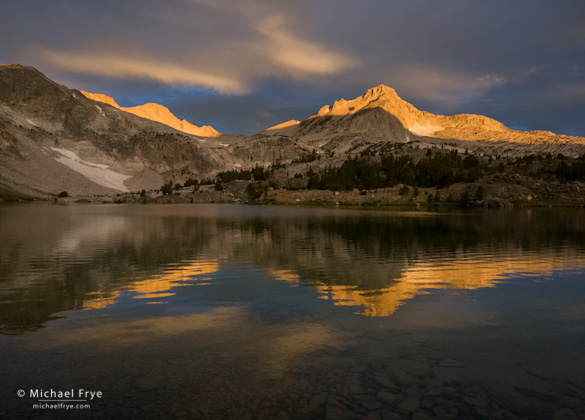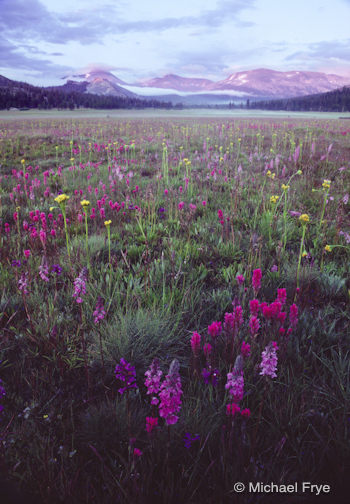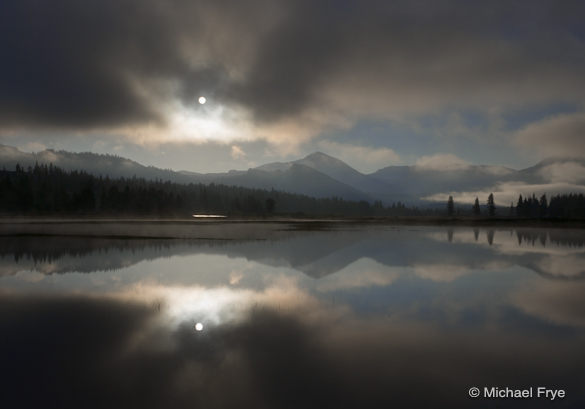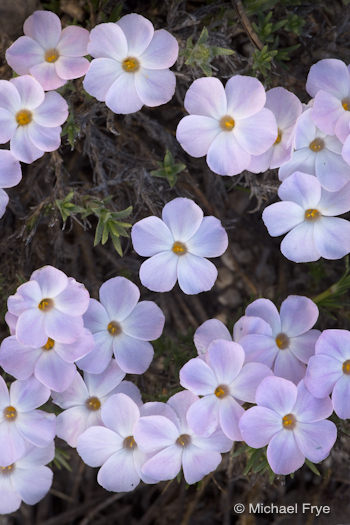by Michael Frye | Aug 16, 2012 | Vision and Creativity

Reeds and Cloud Reflections no. 1
Planning
The future is uncertain, so we try to control it by planning. We think that if we do A and B the result will be C. But sometimes there are too many variables that we can’t account for, so the result might not be C—it could be D, or E, or even Z.
Photographers often try to plan. We imagine that if we go to a certain location at a certain time we’ll capture a certain photograph. Sometimes this works, but frequently the weather doesn’t cooperate or conditions aren’t right.
(more…)
by Michael Frye | Jul 26, 2012 | Workshops

Sunrise illuminates North Peak. I like the rippled reflection, preserved by a fast shutter speed (1/90th sec).
Teaching my Hidden Yosemite workshop last week was so much fun. We had some wonderful clouds to make the skies more interesting, and a great group of people, plus it’s always fun to get away from the roads and into some beautiful areas that you just can’t drive to.
Weather forecasts before the workshop called for clear skies, but our first evening we photographed some amazing lenticular clouds, including two UFO disks over Mammoth Peak, and another formation to the north resembling an Imperial Star Destroyer. Later in the week the sun broke through overcast skies just before sunset and lit up the clouds over Gaylor Lakes, and the next morning we watched sunlight poke through more clouds to illuminate North Peak. And then it snowed. Meteorologists try to predict the future, which is a difficult job. This is one time when I’m glad they were wrong—the clouds definitely made things more interesting.
(more…)
by Michael Frye | Aug 18, 2011 | Critiques, Yosemite Photo Conditions

Wildflowers, Tuolumne Meadows, 1986
It’s wildflower season in the Yosemite high country, which made me think about this image that I made 25 years ago, in August of 1986, in Tuolumne Meadows.
In the 1980s large swaths of Lemmon’s paintbrush and shooting stars were common in Tuolumne Meadows in the summer. But 1986 brought the best bloom I’ve ever seen there, with this great mix of paintbrush, little elephant’s heads, lupine, shooting stars, penstemons, and… that yellow flower (arrowhead butterweed?). For some reason though wildflowers have diminished in Tuolumne Meadows in recent years, and those great blooms seem to be a thing of the past.
In the summer of 1986 I was working at The Ansel Adams Gallery in Yosemite Valley. On the day I made this photograph I drove up to the high country after work. A thunderstorm had rolled through, leaving the meadows wet and the skies overcast. But just before sunset the sun crawled underneath the clouds and lit up the peaks in the distance.
I actually think I did a pretty good job with the composition here. I needed to find some kind of structure or design to hold the foreground together and lead the viewer’s eyes into the distance. The little V- shaped group of flowers at the bottom of the frame accomplished both those things, giving the foreground some structure and leading viewer’s eyes toward the background. As a bonus, that V-shape mirrors the upside down Vs of the peaks.
The horizon line is high, but I think that’s appropriate here: the foreground is much more interesting than the sky. I’m glad I wasn’t overly concerned about putting the horizon a third of the way from the top.
(more…)
by Michael Frye | Jul 21, 2011 | Light and Weather, Yosemite Photo Conditions

Sun breaking through mist, Tuolumne Meadows, last Friday morning
Landscape photographers have to be flexible. You can try to plan—to be at a certain place at a certain time when you expect the light to be just right. But you can’t control the weather, and the best-laid plans of photographers often fizzle behind a bank of clouds.
So when things don’t pan out the way you’d hoped, you have to adapt. We did a lot of adapting last week during my Hidden Yosemite workshop. With our heavy winter and late spring, there was still a lot of snow at higher elevations. Certain areas were just inaccessible; the Saddlebag Lake road, for example, was closed, and I heard the lake was still mostly covered in ice.
(more…)
by Michael Frye | Jul 5, 2010 | Yosemite Photo Conditions
 Claudia and I spent Fourth of July weekend in the Yosemite High Country, scouting for my upcomingHidden Yosemite workshop. There’s still plenty of water flowing in the creeks and rivers, and some big reflecting ponds remain in the west end of the main Tuolumne Meadow. Some flowers have appeared, like the spreading phlox shown here, penstemon along the side of the Tioga Pass Road between Yosemite Creek and Olmsted Point, and a few patches of shooting stars in damp meadows. I’m sure more flowers will be blooming soon. It promises to be a good wildflower year in the high country, but the peak probably won’t arrive until at least early August.
Claudia and I spent Fourth of July weekend in the Yosemite High Country, scouting for my upcomingHidden Yosemite workshop. There’s still plenty of water flowing in the creeks and rivers, and some big reflecting ponds remain in the west end of the main Tuolumne Meadow. Some flowers have appeared, like the spreading phlox shown here, penstemon along the side of the Tioga Pass Road between Yosemite Creek and Olmsted Point, and a few patches of shooting stars in damp meadows. I’m sure more flowers will be blooming soon. It promises to be a good wildflower year in the high country, but the peak probably won’t arrive until at least early August.
My nickname for shooting stars is “mosquito flowers,” because they grow in boggy areas and always seem to blossom at the same time as the mosquitos. Just the sight of shooting stars makes me itchy. And sure enough, the mosquitos were out, but we didn’t encounter any maddening, intolerable swarms. I’m keeping my fingers crossed, hoping that these little pests won’t be too bad this year, but it’s probably just a little too early for them at the higher elevations. But even clouds of mosquitos won’t keep me away—the high country is just too beautiful to miss.













